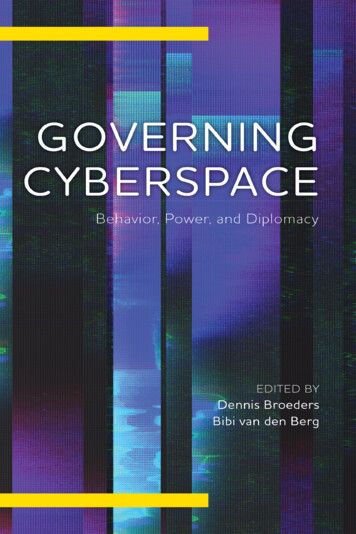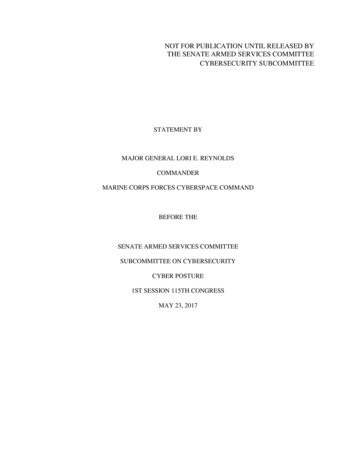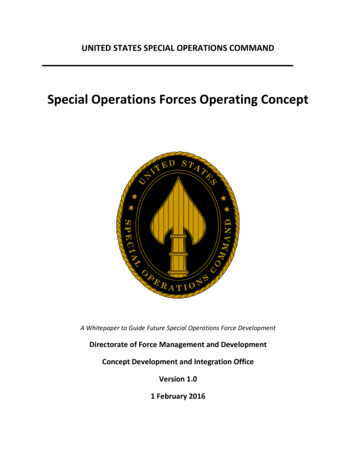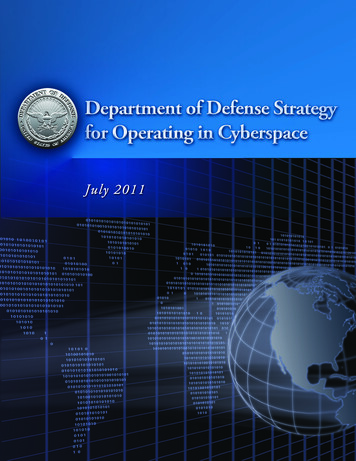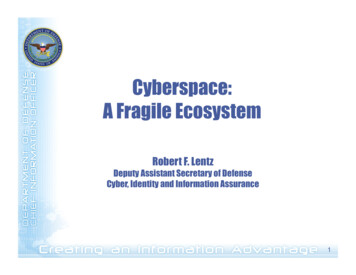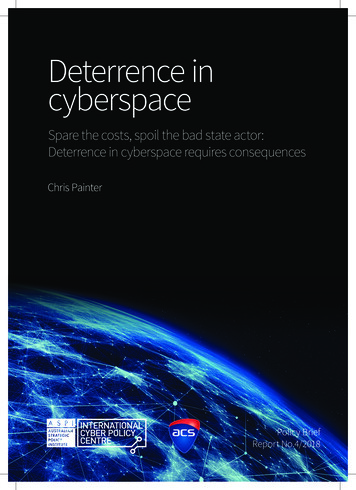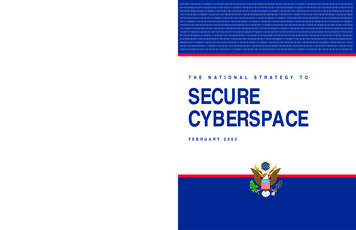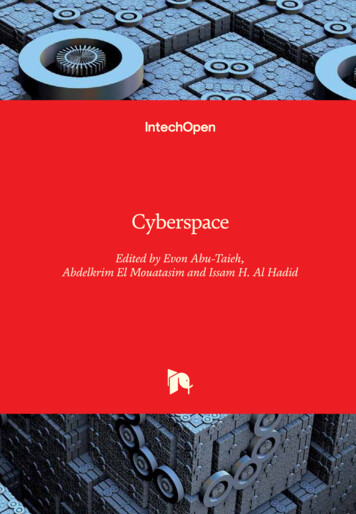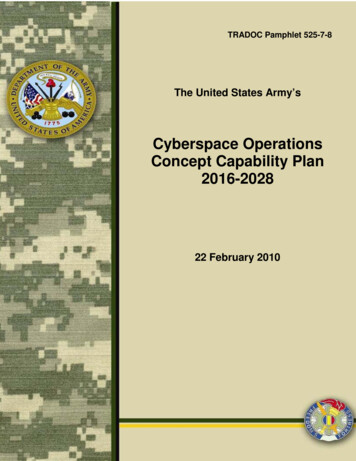
Transcription
TRADOC Pam 525-X-XTRADOC Pamphlet 525-7-8arThe United States Army’sThis page intentionally left blank.Cyberspace OperationsConcept Capability Plan2016-202822 February 2010
TRADOC PAM 525-7-8ForewordFrom the DirectorU.S. Army Capabilities Integration CenterThe U.S. Army Training and Doctrine Command’s assessment of the future operationalenvironment highlights the importance of all aspects of information on the future battlefield.Army forces operate in and among human populations, facing hybrid threats that are innovative,networked, and technologically-savvy. These threats capitalize on emerging technologies toestablish and maintain a cultural and social advantage; leveraging these new capabilities forcommand and control, recruiting, coordinating logistics, raising funds, and propagandizing theirmessage. To operate effectively in this emerging environment, the Army must realign itsinformation "Aim Point." Army leaders and Soldiers must possess an in-depth understanding ofhow to leverage information-based capabilities to gain and maintain situational awareness.Understanding how to fight for and leverage the power of information, while denying theadversary’s ability to do the same, will be increasingly critical to success on the futurebattlefield.The assessment indicates that the Army’s current vocabulary, including terms such ascomputer network operations (CNO), electronic warfare (EW), and information operations (IO)will become increasingly inadequate. To address these challenges, there are three interrelateddimensions of full spectrum operations (FSO), each with its own set of causal logic, andrequiring focused development of solutions: The first dimension is the psychological contest of wills against implacable foes,warring factions, criminal groups, and potential adversaries.The second dimension is strategic engagement, which involves keeping friends athome, gaining allies abroad, and generating support or empathy for the mission.The third dimension is the cyber-electromagnetic contest, which involves gaining,maintaining, and exploiting a technological advantage.The first and second dimensions focus on how commanders and staffs orchestrate andleverage information power to achieve their missions. The third dimension focuses on gainingand maintaining an advantage in the converging mediums of cyberspace and the electromagneticspectrum (EMS). The Army’s construct of gaining advantage, protecting that advantage, andplacing adversaries at a disadvantage is well nested within these dimensions; and contributes tothe outcomes that must be achieved by unified action at the tactical, operational, and strategiclevels. Current operations reinforce our conviction that concepts and capabilities are needed foreach of these dimensions.IO encompasses all three of these dimensions, but is increasingly an overburdened termwhich refers to any use of information. CNO and EW by themselves are insufficient to describethe full scope of the cyber-electromagnetic contest. To this end, we are undertaking acomprehensive campaign to describe fully each dimension. The first two dimensions (thecontest of wills and strategic engagement), will be addressed in a forthcoming, separate conceptcapability plan, and followed by a capability based assessment.i
TRADOC Pam 525-7-8This pamphlet relates EW, CNO, and cyber in this third dimension–the cyberelectromagnetic contest. TRADOC Pam 525-7-8 is the first step in developing a commonunderstanding of how technological advancements transform the operational environment, howleaders must think about cyberspace operations, how they should integrate their overalloperations, and which capabilities are needed. It provides the means to identify outcomes-based,integration-focused, and resource-informed solutions which enable the U.S. Army to prevail inthe cyber-electromagnetic contest.ii
TRADOC PAM 525-7-8Executive SummaryFraming the problemThe operational environment (OE) has changed dramatically. The technologic convergence ofcomputer and telecommunication networks; astonishing rates of technologic advancements;global proliferation of information and communications technology (ICT) and its consequenteffect in social networks and in society impact the OE. The diverse and wide arrays of agentswho use or exploit this technological revolution pose a grave threat to U.S. critical infrastructureand operational missions. These agents range from traditional nation-states to noncombatants,transnational corporations, criminal organizations, terrorists, hacker unions, mischievoushackers, and the unwitting individual who intends no malice. Collectively, they combine tocreate a condition of perpetual turbulence without traditional end states or resolution. Unlessotherwise noted in this document, the terms "adversary" and "adversaries" are used in this broadcontext.Framing the solutionTraining and Doctrine Command (TRADOC) Pamphlet (Pam) 525-7-8, The U.S. Army ConceptCapability Plan for Cyberspace Operation (CyberOps) 2016-2028, takes a comprehensive lookat how the Army’s future force in 2016-2028 will leverage cyberspace and CyberOps. Thispamphlet includes a conceptual framework for integrating CyberOps into FSO, therebyproviding the basis for follow-on doctrine development efforts. This conceptual frameworkoutlines how commanders integrate CyberOps to gain advantage, protect that advantage, andplace adversaries at a disadvantage. This pamphlet also establishes a common lexicon for ArmyCyberOps, and describes the relationship between cyberspace, the other four domains (air, land,maritime, and space), and the EMS. Lastly, it explains how converging technologies willincreasingly affect FSO and influence capability development, thereby enabling the Army toinfluence the design, development, acquisition, and employment of fully integrated cybercapabilities.Solution context: the three dimensions of FSOa. The Commanding General (CG), U.S. Army TRADOC directed the Combined ArmsCenter (CAC) to lead a working group to establish the conceptual framework for theorganization for the cyberspace (cyber), EW, and IO mission areas and TRADOC’s associatedforce modernization proponency structure. On 16 October 2009, the CG TRADOC providedrecommendations to the Army, Vice Chief of Staff. Included among his recommendations werethe following:(1) The CAC determined that current vocabulary (cyber-EW-IO) is adequate today, butwill become increasingly inadequate to describe the challenges the Army faces in the operationalenvironment.(2) The CAC concluded that there are three dimensions to be addressed, that thesedimensions exist across the FSO, and that these dimensions each require force design anddoctrinal solutions.iii
TRADOC Pam 525-7-8(3) Therefore, although the Army currently describes the functions related to networkand spectrum operations as cyber-EW-IO, the CAC believe that the Army should adapt anddescribe them in the future as follows: First dimension - The first dimension is the psychological contest of wills againstimplacable foes, warring factions, criminal groups, and potential adversaries.Second dimension - The second dimension is strategic engagement and involveskeeping friends at home, gaining allies abroad, and generating support or empathy for themission in the area of operations.Third dimension - The third dimension is the cyber-electromagnetic contest 1. Trends inwired, wireless, and optical technologies are setting conditions for the convergence ofcomputer and telecommunication networks.b. TRADOC Pam 525-7-8 is fundamentally about prevailing in this third dimension, thecyber-electromagnetic contest, and provides recognition that CyberOps enables the first twodimensions.Central ideaa. Prevailing in the cyber-electromagnetic contest means making progress at the same timealong three lines of effort: gaining advantage, protecting that advantage, and placing adversariesat a disadvantage.b. Commanders seek to retain freedom of action in cyberspace and in the EMS, whiledenying the same to adversaries at the time and place of their choosing; thereby enablingoperational activities in and through cyberspace and consequently the other four domains.CyberOps encompass those actions to gain the advantage, protect that advantage, and placeadversaries at a disadvantage in the cyber-electromagnetic contest. CyberOps are not an end tothemselves, but rather an integral part of FSO and include activities prevalent in peacetimemilitary engagement, which focus on winning the cyber-electromagnetic contest. CyberOps arecontinuous; engagements occur daily, most often without the commitment of additional forces.Solution frameworkCurrent doctrinal terms do not adequately address the broad range of tasks associated withinDepartment of Defense (DOD) definitions of cyberspace and CyberOps. Consequently, theframework developed for TRADOC Pam 525-7-8 establishes four components for CyberOps:cyber warfare (CyberWar), cyber network operations (CyNetOps), cyber support (CyberSpt) andcyber situational awareness (CyberSA).1The use of the term cyber-electromagnetic is not meant to equate the terms cyberspace and electromagnetic spectrum, but rather to highlightthere is significant overlap between the two and future technological development is likely to increase this convergence.iv
Department of the ArmyHeadquarters, United States ArmyTraining and Doctrine CommandFort Monroe, Virginia 23651-1047TRADOC Pamphlet 525-7-822 February 2010Military OperationsCYBERSPACE OPERATIONS CONCEPT CAPABILITY PLAN 2016-2028FOR THE COMMANDER:OFFICIAL:DAVID P. VALCOURTLieutenant General, U.S. ArmyDeputy Commanding General/Chief of StaffHistory. This publication is a new U.S. Army Training and Doctrine Command (TRADOC)concept capability plan developed as part of the Army Concept Framework for the future forceand as part of the capabilities-based assessment (CBA) process.Summary. TRADOC Pam 525-7-8 takes a comprehensive look at how the Army’s future forcein 2016-2028 will leverage cyberspace and CyberOps. This pamphlet includes a conceptualframework for integrating CyberOps into full spectrum operations (FSO), thereby providing thebasis for follow-on doctrine development efforts. This conceptual framework outlines howcommanders integrate CyberOps to gain advantage, protect that advantage, and place adversariesat a disadvantage. This pamphlet establishes a common lexicon for Army CyberOps, anddescribes the relationship between cyberspace, the other four domains (air, land, maritime, andspace), and the electromagnetic spectrum (EMS). TRADOC Pam 525-7-8 explains howconverging technologies will increasingly affect FSO and influence capability development;thereby enabling the Army to influence the design, development, acquisition, and employment offully integrated cyber capabilities.Applicability. TRADOC Pam 525-7-8 is the foundation for future force development and thebase for subsequent developments of supporting concepts, concept capability plans, and the JointCapabilities Integration and Development System (JCIDS) process. It supports experimentationdescribed in the Army Capabilities Integration Center (ARCIC) Campaign Plan and functions asthe basis for developing solutions related to the future force within the doctrine, organizations,
TRADOC Pam 525-7-8training, materiel, leadership and education, personnel, and facilities (DOTMLPF) domains.This pamphlet applies to all TRADOC, Department of Army (DA) and Army Reservecomponent activities that develop DOTMLPF requirements.Proponent and supplementation authority. The proponent of this pamphlet is the TRADOCHeadquarters, Director, ARCIC. The proponent has the authority to approve exceptions orwaivers to this pamphlet that are consistent with controlling law and regulations. Do notsupplement this pamphlet without prior approval from Director, TRADOC ARCIC (ATFC-ED),33 Ingalls Road, Fort Monroe, VA 23651-1061.Suggested Improvements. Users are invited to submit comments and suggested improvementsvia The Army Suggestion Program online at https://armysuggestions.army.mil (ArmyKnowledge Online account required) or via DA Form 2028 to Director, TRADOC ARCIC(ATFC-ED), 33 Ingalls Road, Fort Monroe, VA 23651-1061. Suggested improvements may alsobe submitted using DA Form 1045.Availability.This regulation is tmontheTRADOChomepageat2
TRADOC Pam 525-7-8ContentsPageForeword . iExecutive Summary . iii1-1. Relevance . 51-2. Purpose . 51-3. Scope . 51-4. Method . 61-5. Key definitions . 61-6. Relation to joint and Army concepts . 61-7. References . 81-8. Explanation of abbreviations and terms . 8Chapter 2 Framing the Environment.82-1. Cyberspace, the domain . 82-2. Cyberspace and the OE . 92-3. The cyber threat . 132-4. Summary . 13Chapter 3 Framing the Problem .143-1. What has changed in the operational environment as pertains to cyberspace? . 143-2. What has changed in operational requirements as pertains to cyberspace? . 143-3. What is working, what is not working? . 143-4. The problem . 15Chapter 4 Framing the Solution .154-1. The context: The three dimensions of FSO . 154-2. Central idea . 164-3. The framework . 174-4. Risks . 254-5. Summary . 26Appendix A References .27Appendix B Interdependent Nature of CyberOps .30B-1. Introduction . 30B-2. Operational overview 1 (OV-1) . 30Appendix C Operational Vignettes .34C-1. Vignette context . 34C-2. Prephase 0 operations . 34C-3. Vignette 1: phase 0 through phase 1, shape and deter . 35C-4. Vignette 2: Phases 1 and 2, force deployment . 39C-5. Vignette 3: Phases 2-4, major combat operations (MCO) . 43C-6. Summary . 46Appendix D Required Capabilities .46D-1. Introduction . 46D-2. DOTMLPF required capabilities. 47Appendix E Required Capabilities Supplemental (Classified) .57Appendix F DOTMLPF Integrated Question List .57F-1. Introduction. 57F-2. Implications . 583
TRADOC Pam 525-7-8F-3.F-4.F-5.F-6.F-7.F-8.F-9.Doctrine . 59Organization . 60Training. 60Materiel . 61Leadership and education . 62Personnel. 62Facilities . 63Table ListTable D-1 Required CyNetOps capabilities . 47Table D-2 Required CyNetOps capabilities by echelon . 51Table D-3 Required CyberWar capabilities . 52Table D-4 Required CyberWar capabilities by echelon . 53Table D-5 Required CyberSpt capabilities . 54Table D-6 Required CyberSpt capabilities by echelon . 55Table D-7 Required CyberSA capabilities . 55Table D-8 Required CyberSA capabilities by echelon . 57Figure ListFigure 2-1. The three layers of cyberspace . 8Figure 2-2. Cyberspace connectivity . 11Figure 2-3. Infrastructure relationships in cyberspace . 12Figure 4-1. The four components of CyberOps . 18Figure 4-2. CyNetOps . 19Figure 4-3. CyNetOps . 20Figure 4-4. CyberWar . 21Figure 4-5. Cyber support . 22Figure 4-6. Enabling CyberOps capabilities and enabling ways . 24Figure B-1. Operational overview 1 . 31Figure C-1. The joint operations six phase model . 34Figure C-2. Vignette 1: phases 0 & 1 – shape and deter. 35Figure C-4. Vignette 3: phases 2, 3, and 4 – seize initiative, dominate, and stabilize. 434
TRADOC Pam 525-7-8Chapter 1Introduction1-1. Relevancea. The operational environment (OE) has changed dramatically. Unprecedented levels ofadverse activity in and through cyberspace threaten the integrity of United States (U.S.) criticalinfrastructure, financial systems, and elements of national power. These threats range fromunwitting hackers to nation-states, each at various levels of competence. Collectively, the threatscreate a condition of perpetual turbulence without traditional end states or resolution. Unlessotherwise noted in this document, the terms "adversary" and "adversaries" are used in this broadcontext.b. The ever-increasing rate of technologic advances and its wide proliferation make itincreasingly difficult to achieve success across the military FSO. The convergence of wired,wireless, and optical technologies has led to the merging of computer and telecommunicationnetworks; handheld computing devices continue to grow in number and capability. Nextgeneration systems are beginning to emerge, forming a global, hybrid, and adaptive network thatcombines wired, wireless, optical, satellite communications, supervisory control, and dataacquisition (SCADA), and other systems. Soon networks will provide ubiquitous access to usersand enable them to collaborate when needed in near real time.c. The Nation’s adversaries’ ability to stay apace with the accelerating rate of technologicchange complicates the OE. A significant advantage will go to the side that gains, protects, andexploits advantage in the contested and congested cyberspace and EMS. Conversely, the sidethat fails in this contest, or that cannot operate effectively when their systems are degraded ordisrupted, cedes a significant advantage to the adversary.d. Gaining, protecting, and exploiting the advantage will not be easy. U.S. adversaries usethe commercial marketplace as their combat developer, which makes them much more nimbleand adaptive than the Army’s lengthy research, development, test, evaluation, and acquisitionprocesses. Adversaries increasingly capitalize on cyberspace and electromagnetic capabilitiesand activities, while to date those capabilities and activities too often have been peripheral to ourArmy’s normal operations. To seize and maintain the operational and tactical advantage againstsuch adaptive adversaries, Army forces must make cyberspace and the EMS central and routinecomponents of its operations; and commanders will need, among other things, the associatedcapabilities, and the corresponding subject matter expertise to apply them.1-2. PurposeThe purpose of TRADOC Pam 525-7-8 is to examine how the Army’s future force in 2016-2028will integrate cyberspace capabilities and CyberOps as part of FSO.1-3. ScopeTRADOC Pam 525-7-8 provides an initial examination of how CyberOps are integrated with thecommander's other capabilities to gain advantage, to protect that advantage, and to placeadversaries at a disadvantage in FSO. The examination will be refined through the CBA and5
TRADOC Pam 525-7-8doctrine development process. This pamphlet describes how commanders seek to retain freedomof action in cyberspace and in the EMS, while denying the same to their adversaries at the timeand place of the Army’s choosing; thereby enabling other operational activities in and throughcyberspace as well as in the other four domains. This pamphlet establishes a common lexiconand framework for CyberOps and describes the relationship between cyberspace, the air, land,maritime and space domains, and the EMS. It also explains how converging technologies willincreasingly affect FSO and influence capability development; identifies CyberOps and enablingcapabilities needed to support future force modernization initiatives; and presents cyberspace andEMS study issues suitable for experimentation.1-4. MethodThis pamphlet leverages the TRADOC-approved design process. Chapter 2 describes theexisting and desired conditions of the operational environment as they pertain to cyberspace.Chapter 3 compares the existing conditions in the operational environment to the desired endstate; thereby establishing the hypothesis for framing the solution. Chapter 4 establishes theframework, central and supporting ideas, and lexicon. Appendix A contains the required andrelated references. Appendix B introduces the evolving cyber operational structure. Appendix Cdescribes how CyberOps are integrated as part of the overall operation to achieve thecommander's intent and objectives, and not an end to themselves. Appendices D (unclassified)and E (classified) discuss required capabilities. Appendix F provides the operative questionsacross DOTMLPF to help with the initial steps of the ensuing CBA.1-5. Key definitionsa. Cyberspace is defined as, "A global domain within the information environmentconsisting of the interdependent network of information technology infrastructures, including theInternet, telecommunications networks, computer systems, and embedded processors andcontrollers." 2b. CyberOps are, "The employment of cyber capabilities where the primary purpose is toachieve objectives in or through cyberspace. Such operations include computer networkoperations and activities to operate and defend the global information grid (GIG)." 3c. EMS is the range of frequencies of electromagnetic radiation from zero to infinity. It isdivided into 26 alphabetically designated bands."1-6. Relation to joint and Army conceptsa. TRADOC Pam 525-7-8 is compatible with joint and Army concepts including theCapstone Concept for Joint Operations and the Army capstone concept. The capabilitiesdescribed in this pamphlet are nested with the joint capability areas (JCA) and warfighting2Deputy Secretary of Defense Memorandum, dated 12 May 2008, defined cyberspace. This pamphlet is anchored in the approved DODdefinition of cyberspace but there are still multiple perspectives as to the characterization of cyberspace as a domain.3Deputy Secretary of Defense Memorandum, dated 15 October 2008, defined CyberOps. The memo also states that operations which may causeeffects in cyberspace (such as, EW, psychological operations) but do not employ cyber capabilities should not be considered CyberOps; and itrecommends the common usage of the modifier "cyber" to mean "cyberspace" (such as, cyber attack, cyber defense, and CyberOps.) A Chief,Joint Chief of Staff memo, dated 18 August 2009, updated the DOD definition for cyberspace operations.6
TRADOC Pam 525-7-8functions. The DOD uses JCAs to describe how capabilities support the joint functions. JCAsform the basis of the DOD’s capabilities based processes and CyberOps capabilities are nestedunder the Tier 1 JCAs of force application, protection, battlespace awareness, and net-centricoperations. In the same way, CyberOps capabilities enable and are an integral part of the Army'swarfighting functions and elements of combat power.b. TRADOC Pam 525-3-0. TRADOC Pam 525-3-0 recognizes that war is a contest of willsand in order to prevail, the Army must exert a psychological and technical influence as one of theconcept's six supporting ideas. The capstone concept states that Army forces are increasinglydependent on electromagnetic, computer network, and space-based capabilities that areconverging; therefore exerting technical influence will require forces that are prepared to fightand win on an emerging "cyber-electromagnetic battleground." Because technology that effectshow information moves changes so rapidly, the Army must evaluate continuously whatcompetencies and capabilities are required to gain, protect, and exploit advantages in highlycontested cyberspace and EMS. This pamphlet supports the capstone concept by identifyingrequired capabilities necessary for successful FSO.c. TRADOC Pam 525-3-1 and TRADOC Pam 525-3-2. These pamphlets support theArmy’s operating concepts by identifying the required capabilities for battle command,intelligence, fires, and protection required to execute effective operational and tactical maneuverin the future operational environment. Cyber capabilities and leveraging cyberspace are criticalfor the Army’s future force to be a
Training and Doctrine Command (TRADOC) Pamphlet (Pam) 525-7-8, The U.S. Army Concept Capability Plan for Cyberspace Operation(CyberOps) 2016-2028, takes a comprehensive look at how the Army's future force in 20162028 will leverage cyberspace and CyberOps.
